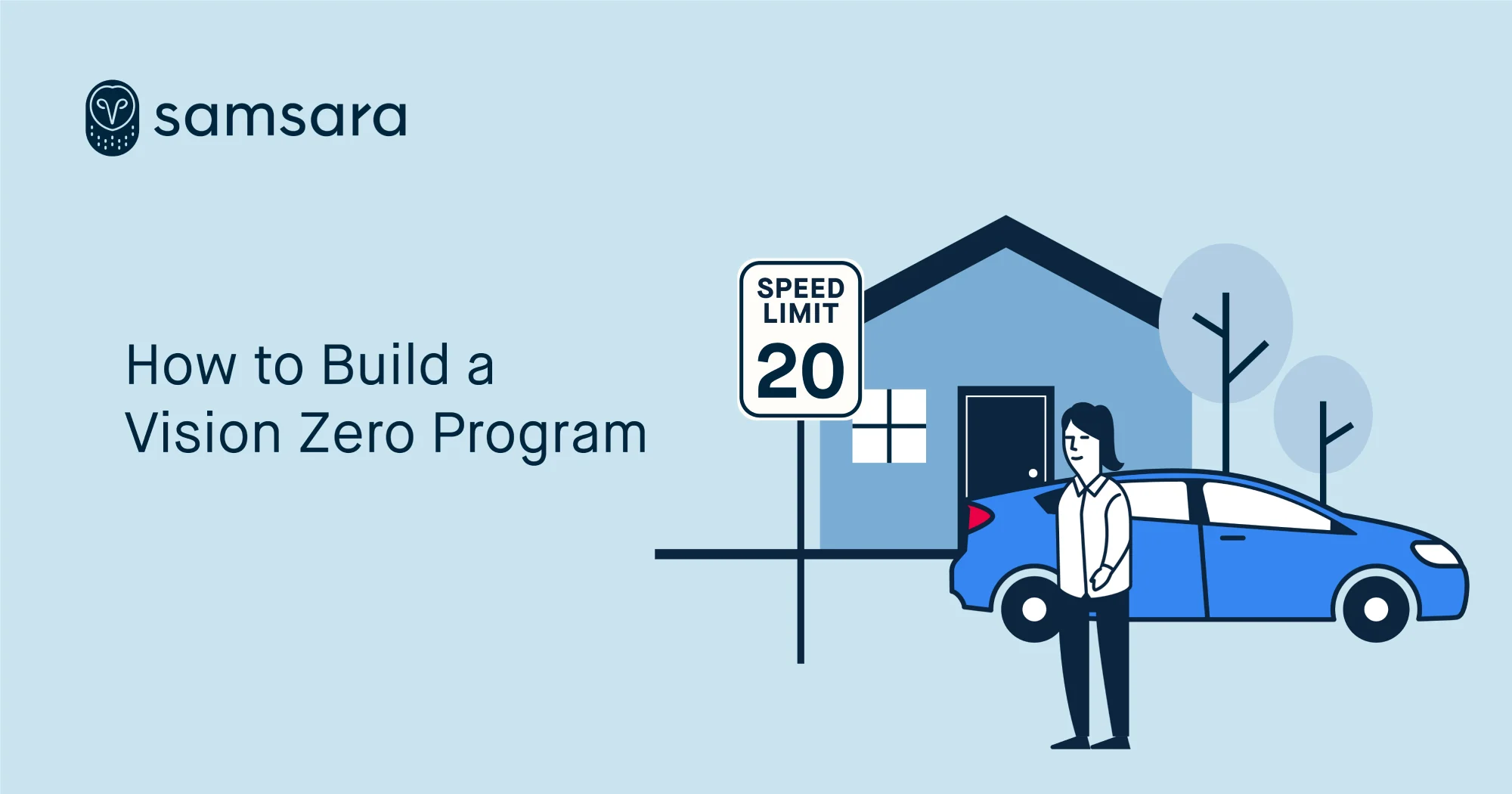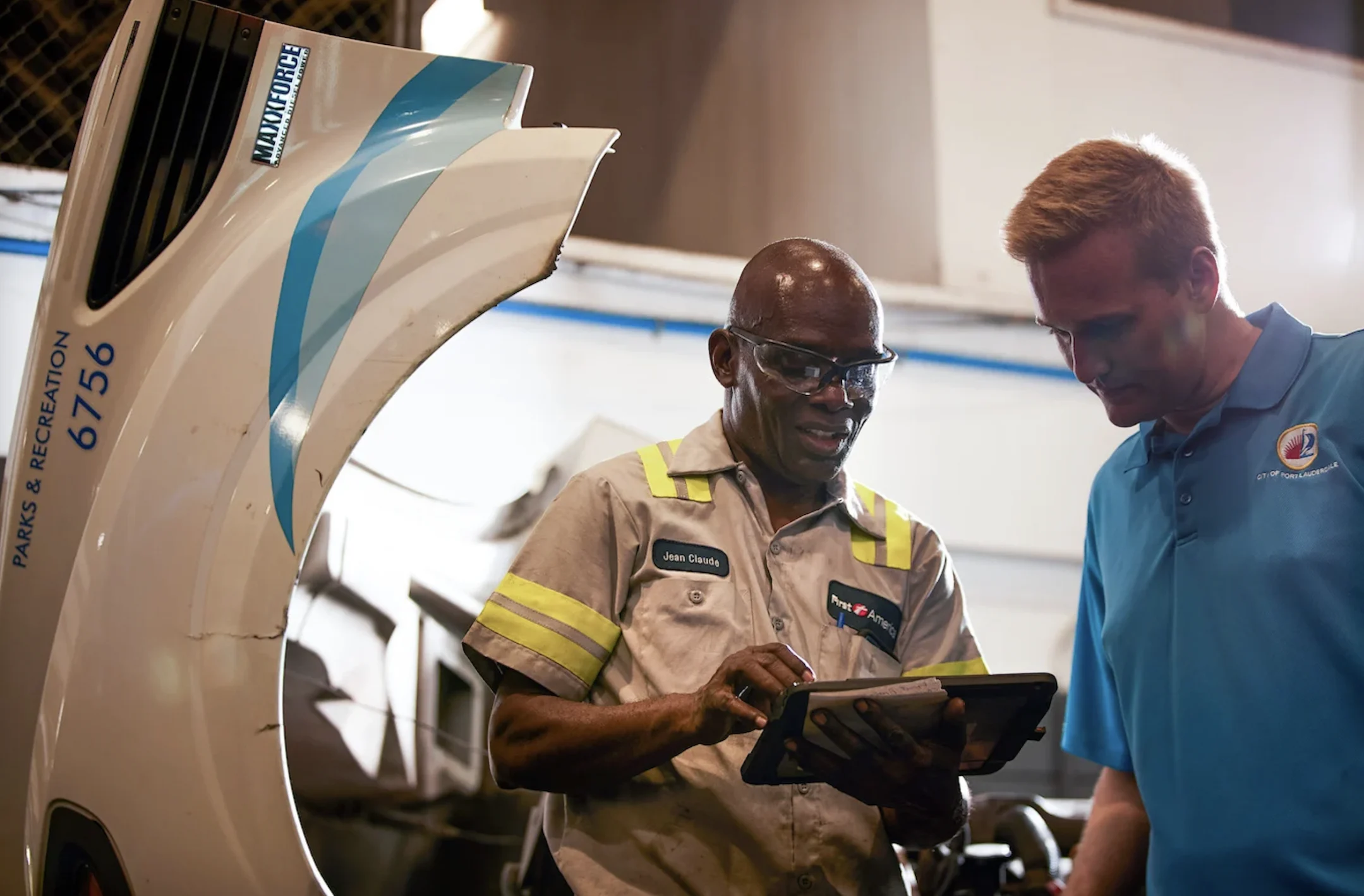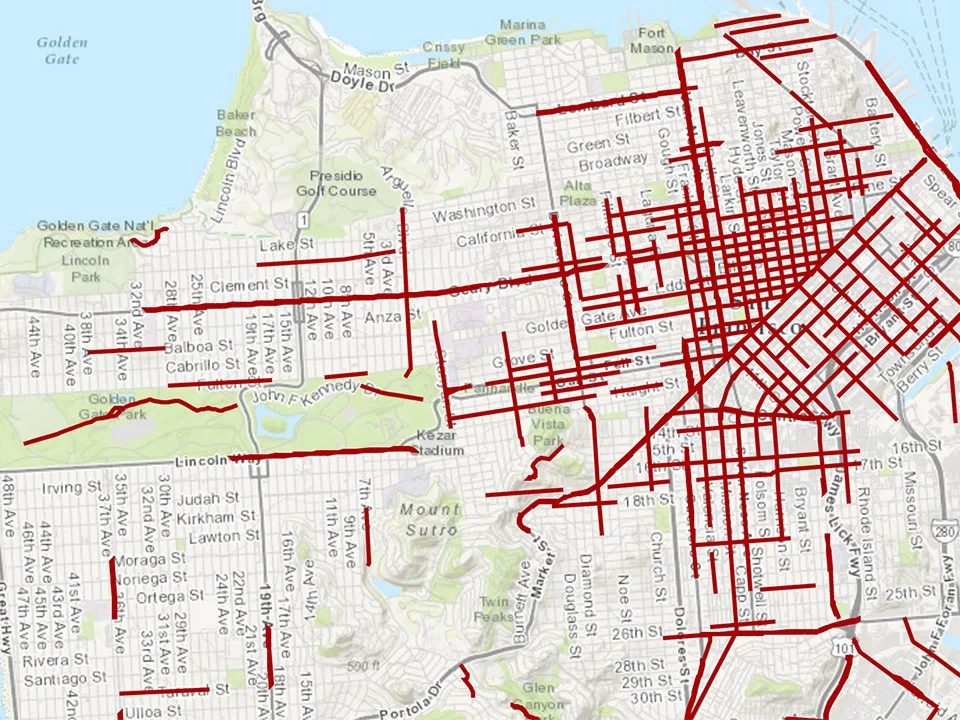How to Build a Vision Zero Program
June 27, 2022

Get Started with Samsara
Check our pricesKey Takeaways
Vision Zero is a different way of approaching traffic safety, involving various stakeholders, strategies, and technology. In this guide we'll explain what Vision Zero is, how to build a Vision Zero Action Plan, and how to use video-based safety solutions to take your Vision Zero program to the next level.
By 2050, roads across the United States may look drastically different. The U.S. has set a Vision Zero goal, which aims to eliminate traffic fatalities and severe injuries on the road using strategic campaigns, policy changes, and system design.
The wheels are already spinning towards a national goal to eliminate traffic deaths. To help U.S. cities plan and implement their Vision Zero initiatives, $1 billion of the Safe Streets and Roads for All (SS4A) program will be available in 2022. More than 45 U.S. cities have already committed to Vision Zero, building safer transportation systems for their communities and the citizens they serve.
You can also be ready to participate in Vision Zero and be eligible for funding by having a comprehensive Vision Zero Action Plan on hand. In this guide, we’ll cover how you can build a Vision Zero Action Plan by mobilizing key stakeholders, using data to build a High Injury Network (HIN), and investing in the right safety technology.
What is Vision Zero?
Vision Zero is an innovative approach to traffic safety, involving various stakeholders, strategies, and technology to minimize roadway fatalities and serious injuries. Vision Zero asserts that traffic deaths are preventable and human failings will happen. Many people and factors—from drivers and pedestrians, to the rules of the road—is responsible for creating a safe and functional transportation system.
In practice, Vision Zero initiatives require communities to identify high-risk areas, events, and demographics; adopt targeted policies and technologies to reduce risk; and educate the general public on safe driving practices. Some examples of Vision Zero outcomes include:
Adopting technology such as safety cameras across city fleet vehicles to improve visibility and decrease traffic collisions.
Adjusting speed limits to reduce speeding.
Restructuring street designs to improve accessibility and influence traffic patterns.
Enacting new transit, bicyclist, and pedestrian policies to improve safety.
Implementing automated speed enforcement to improve efficiency and accountability.
Installing traffic lights and street signs to modify driver behavior.
Launching campaigns to educate the public on traffic safety.
To build a Vision Zero Action Plan, you’ll need a dedicated task force, data to develop a High Injury Network (HIN), and the right safety technology.
<div class="text-center"><a id="blog-inline-1" href="/industries/state-local-government" title="Learn more about Samsara" class="btn primary-btn teal btn--blue">Learn more about Samsara</a></div>
How do you build a Vision Zero Action Plan?
1. Assemble a Vision Zero Task Force to mobilize key stakeholders
Building a comprehensive Vision Zero program involves drawing from interdisciplinary perspectives, and requires buy-in from multi-agencies across a variety of sub-industries to succeed. You’ll need commitment and resources from a variety of stakeholders and departments. For broad initiatives like Vision Zero, collaboration is key for securing joint departmental budgeting.
Some stakeholders that may be involved in a Vision Zero Task Force include:
Office of the Mayor
City Council
Department of Transportation
Public Health
Public Works
District Attorney
School District
Office of Management and Budget
Putting any city safety project in motion involves working in partnership with these stakeholders to affect change. Let’s say your city has experienced a large number of high speed accidents and has pinpointed a zone of streets and intersections where they most commonly occur. One solution to mitigate high speed accidents is to reduce the speed limit for at-risk roadways.
Reducing the speed limit isn’t so simple as changing a set of numbers—you’ll need to mobilize a task force that spans many different disciplines. While every city goes about this process differently, here is a simplified overview of the process that may be required for reducing the speed limit in a given zone:
The Department of Transportation (DOT) first needs to appeal the case for adjusting the speed limit at a given zone to local jurisdictions.
The DOT will consult relevant agencies such as Highway Patrol, law enforcement, and city engineers to discuss the proposed speed limit change.
Public hearings will be conducted by a city council, and elected officials will legislate on the decision.
Civil Engineers and Traffic Analysts compile and approve collision data, schematic plans, and documentation.
The City’s Legal team will write and review new speed zone orders, which, once completed, are voted on by local jurisdictions.
Once passed, an official memo is presented to the District Director for final review. The speed limit change is now ready for distribution.
The Public Works team will start executing the order, which may include installing speed limit signs or curve advisory signs, changing geometry, applying pavement markings, or making more significant street design changes.
Internal stakeholders—such as law enforcement, local authorities, and the court system—and the general public are educated on the new speed limit through additional outreach and campaigns.

The City of Fort Lauderdale is one example of a city that has developed an effective Vision Zero Action Plan. Despite a population of only 180,000 people, the City of Fort Lauderdale dialed in at number two in the US for traffic deaths. Developing a Vision Zero Action Plan unique to their needs was the first step in creating a safer transportation system for the citizens in Fort Lauderdale.
City staff and other relevant agency stakeholders created the Zeroing In 2022 Five-Year Action Plan to improve connectivity and mobility across high-risk intersections in Fort Lauderdale. Some of the objectives the action plan detailed include:
Reducing crashes at specific areas through street designs.
Advocating for policy changes to make streets safer for all road users.
Raising awareness for Vision Zero and safe driving with marketing and outreach.
Adopting technology such as fleet tracking solutions to improve visibility and decrease downtime.
Putting these strategies in practice, the City of Fort Lauderdale installed new crosswalks, designed new infrastructure for speed limits, and launched campaigns to educate citizens on safe driving. As a result of Fort Lauderdale’s Vision Zero program, they reduced their total crashes across five years by 21%.
2. Evaluate your city’s traffic safety infrastructure with an HIN
Vision Zero’s community-driven mission often needs a data-backed approach to be most effective. While most on-the-road accidents are unplanned and random, data around who, when, where, and how traffic crashes happen can surface patterns that enable you to anticipate and minimize accidents.
Who is impacted: The demographic of individuals involved in accidents such as age, gender, ethnicity, income, or vehicle type.
When accidents most frequently occur: The time of year, week, or day when accidents happen most frequently.
Where accidents most frequently occur: The location, roadway condition, and nearby geographies where accidents happen.
How accidents occur: The type of accidents that most frequently occur (such as speeding-related incidents, rear-ends, sideswipes, or impairment-related crashes) and their severity.
From this data, you can develop a High Injury Network (HIN) to inform your Vision Zero initiatives. An HIN is a framework that uses quantitative data to map out trends in the city where traffic fatalities or serious injuries most frequently occur.

Across most major cities, data from HINs indicate that a small percentage of a city’s streets account for a majority of severe traffic accidents. For example, San Francisco’s HIN assessment shows that 13% of city street miles contribute to 75% of fatalities. By visualizing which streets and intersections are most commonly putting pedestrians, bicyclists, and other motorists at risk, your city staff can focus resources on the areas that need it most and create countermeasures to minimize severe injuries.
For the City of Fort Lauderdale, they were able to streamline their operations and improve citizens’ quality of life by using data insights to inform key decisions. “There is a lot that goes into delivering the services that people have come to expect,” said Chris Lagerblom, City Manager. “Collecting good data is important in making decisions in how we deliver services.”
3. Invest in the right safety technology to minimize serious injuries
On top of policy and infrastructure changes, a successful Vision Zero project will account for the human component involved in roadway accidents. Even with every countermeasure in place, traffic collisions, speeding, and other on-the-road events are inevitable.
Especially as budget and police resources become limited, investing in technology is critical to proactively help keep drivers accountable, minimize traffic crashes, and improve safety for all road users. One such technology that is helping cities reduce roadway accidents are safety cameras, including red light cameras for high crash corridors and vehicle cameras for city fleets.
Mounting red light cameras at high crash corridors is a common countermeasure to influence driver behavior and reduce speeding. Since specific high speed corridors (often specific streets or intersections) generally experience a disproportionate number of accidents, local municipalities are using cameras to monitor speeding violations and issue citations to offenders who go above the speed limit. More than 4,150 traffic cameras have been installed across major city streets in the U.S., providing cities with some visibility into unsafe driving.
However, red light cameras can only go so far in improving road safety. Increasingly, cities leading the way are going beyond red light cameras by implementing innovative technology within their own city fleet—buses, public works vehicles, and beyond. City fleet vehicles, often large and difficult to operate, may have blind spots that impair a driver’s vision. Using vehicle safety cameras such as exterior cameras and interior cameras, cities can improve visibility, coach city employees on safe driving, and reduce accidents.
Exterior cameras, such as side cameras and rear cameras, are installed on the outside of the vehicle, providing a full perimeter view. Exterior cameras can help reduce incidents like sideswipes while capturing high-definition video footage of on-the-road events in case of a not-at-fault accident or false claim.
Interior cameras, such as dash cams, are installed on the windshield of the vehicle. Forward-facing or dual-facing dash cams can prevent accidents in real time with in-cab alerts for unsafe behaviors like speeding and distracted driving. Administrative teams can also use dash cam footage to coach drivers in response to unsafe driving behavior.
<div class="text-center"><a id="blog-inline-1" href="/industries/state-local-government" title="Learn more about Samsara" class="btn primary-btn teal btn--blue">Learn more about Samsara</a></div>
How Samsara can take your Vision Zero program to the next level
The road towards zero traffic fatalities and safer streets across the U.S. is within reach. Over the next five years, $5 billion will be granted to funding Vision Zero programs for U.S. cities. Local agencies and municipalities can be ready for funding and stay ahead of the curve by building a Vision Zero action plan, which includes mobilizing key stakeholders, using data to build a High Injury Network (HIN), and investing in the right safety technology.
Samsara is one such technology that can take your Vision Zero program to the next level. Samsara offers a comprehensive solution that enables government agencies to elevate their Vision Zero program to create safer transportation systems. Using Samsara’s video-based safety solutions, you can improve visibility, unify your safety-related data, and reduce serious injuries.
Samsara's video-based safety solution can help you achieve your Vision Zero goals:
Get 360° visibility into the safety of your city: Reduce injuries and fatalities for your city’s public areas and fleet vehicles with intelligent security cameras, AI dash cams, side, rear, and interior video for instant livestream.
Ensure employees aren’t breaking the law: Monitor seat belt usage, distracted driving, uniforms, or tailgating with automated tools and footage to train, reward, and coach city employees who operate vehicles.
Investigate and understand safety incidents faster and more holistically: Resolve incidents faster with centralized video, immediate alerts, and controlled access to live stream footage at your fingertips for instant review.
Looking for more ways to reduce accidents and build safer streets? Check out our article about how the internet of things (IoT) is transforming urban areas. If you’d like to learn more about the Samsara platform, reach out for a free trial.
<div class="text-center"><a id="blog-inline-1" href="/industries/state-local-government" title="Learn more about Samsara" class="btn primary-btn teal btn--blue">Learn more about Samsara</a></div>